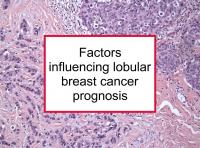Lobular breast cancer is more likely to be multifocal (more than one tumor per breast), bilateral (in both breasts), and hormone receptor positive (ER+/PR+) than ductal breast cancer, the most common type. This webpage describes factors influencing lobular breast cancer prognosis. Please see also lobular BC survival data.
Use of hormone replacement therapy (HRT), or menopausal hormone therapy, containing both estrogen and progestin has been shown to increase the risk of invasive lobular breast cancer. Being overweight also increases the risk of lobular breast cancer and recurrence after menopause. Palpable lobular tumors (i.e., those that can be felt by hand even if only as a firmer area) are associated with higher tumor grade and worse overall survival than nonpalpable lobular tumors.
Although still rare, women with lobular breast cancer are more likely to get ovarian and gastric (stomach) metastases than those with other types of breast cancer. While lobular breast cancer may have indolent, non-aggressive characteristics compared to ductal breast cancer and other types, both the primary tumor in the breast and distant metastases can be difficult to detect. As a result, long-term prognosis is not superior to that of ductal breast cancer.
LCIS increases invasive breast cancer risk
Women with lobular carcinoma in situ (LCIS), also known as lobular neoplasia, are at higher than average risk for invasive breast cancer, but the risk is elevated for developing ductal as well as lobular breast cancer. One study found that the seven-year cumulative invasive breast cancer incidence was 9.9% after an initial diagnosis of atypical hyperplasia or LCIS. A 2020 study reported that 7.8% of women with atypical hyperplasia and 5.7% of women with LCIS developed invasive breast cancer during the first ten years after diagnosis. Efforts to predict which LCIS patients will progress to invasive breast cancer have so far been unsuccessful.
Lymph node micrometastases in lobular breast cancer
As is the case for other types of breast cancer, lobular breast cancer patients with positive lymph nodes have worse prognosis than those with clear lymph nodes. However, the significance of lymph node micrometastases appears to differ.
Micrometastases include metastases of 2 mm or less, tiny cell clusters, and isolated tumor cells. Generally speaking, micrometastases in lymph nodes have not been found to significantly influence breast cancer prognosis. Since identifying micrometastases requires more intensified pathological assessment of lymph nodes, such findings could result in reduced use of techniques to find micrometastases (metastases which would otherwise remain occult or undetected).
However, because of the diffuse nature of lobular breast cancer, lymph node metastases are more likely to be micrometastases than in ductal breast cancer. Forgoing pathological techniques that could find otherwise undetectible micrometastases in lobular breast cancer cases might cause some tumors to be incorrectly staged.
Multifocal and contralateral tumors
As noted above, lobular breast cancer is more likely to be multifocal or bilateral than other breast cancer types. While five-year survival rates are similar, ten-year survival rates are lower for multifocal breast cancer. In addition, five-year survival rates are lower for women with contralateral breast cancer compared to those with tumors only in one breast. This appears to be because bilateral breast tumors tend to have more aggressive characteristics. MRIs of both breasts before surgery to identify all tumors could be beneficial for lobular breast cancer patients. The higher possibility of undetected lesions in lobular breast cancer argues for systemic treatment in addition to lumpectomy and radiotherapy even for relatively small tumors.
Factors associated with recurrence
A large Swedish study, which followed women with lobular breast cancer for over 20 years, reported that positive lymph node status, high proliferation (defined as Ki-67 ≥ 30%), and significant tumor size (≥ 20 mm) each were associated with recurrence. Triple negative (ER-/PR-/HER2-) lobular breast cancer had relatively poor prognosis.
Another study found that lobular breast cancer patients with clear lymph nodes, low proliferation and small tumor size had favorable long-term outcomes, with a breast cancer mortality rate of 12% after 20 years.
A 2023 study reported that early recurrence (less than five years after diagnosis) was associated with larger tumor size (average 4.2 cm compared to 2.9 cm for late recurrence), greater number of positive lymph nodes (32% > 3 positive nodes compared to 9%), and more aggressive tumor biology (low or negative progesterone receptor expression, higher grade, and higher Ki-67) than late recurrence (at least five years after diagnosis). Early, but not late, recurrence was also associated with omission of adjuvant endocrine therapy or radiation treatment after lumpectomy.
Late recurrence was also found to be associated with younger age (average 55.6 years compared to 59.2 years for early recurrence) and higher BMI (BMI > 25 kg/m2 in 60% of cases compared to 45%).
Sources of information provided in this webpage
The information above, which is updated continually as new research becomes available, has been developed based solely on the results of academic studies. Clicking on any of the underlined terms will take you to its tag or webpage, which contain more extensive information.
Below are links to 20 recent studies concerning this topic. For a more complete list of studies, please click on the tag lobular breast cancer. Please also see our articles on lobular breast cancer survival data, lobular breast cancer characteristics and diet for lobular breast cancer patients and survivors.
